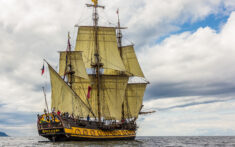In 1984, it came to light the prince publication graffiti of Valencia area; Graffiti medieval Castell de Dénia. It was the result of the systematic catalog of more than three hundred, carried out by a group of researchers, under the auspices of the Casa de Velázquez, who carefully analyzed the evidence of traces on walls, towers and other defensive structures, as well as inside some rooms of the monumental complex of the castle.

Ships, as related to the sea and seamanship elements are one of the most relevant and important content of existing graffiti at the foot of our walls, front, along with views of the harbor and the sea of Dénia . We focus on a suggestive panel of more than seven meters in length, with subsections graffiti on plastering the walls of Dénia. It is located in a segment canvas fence that surrounded the Vila de Dénia, founded by Jaume II in 1308. It is known as Sector A and belongs to the northern walls of the Vila, including the Powder Tower and the tower of oval plant.
Graffiti are arranged in a horizontal band corresponding to the external face of the first (bottom) of the tapiadas that crowned with rectangular crenellations, were potent paintings of the wall of the medieval village. After the founding of the Vila, the old site of the former andalusí albacar has a series of renovations, aimed at increasing its height and give more strength to the walls. In line with the repair and construction documented in the castle, in 1386, in the so-called Palau Vell and other annexed areas, which have detailed settlement expenses ledgers, and the walls of the suburb, in 1388 in times of Count Alfons d'Arago Denia [Alfons el Vell] royal Duke of Gandia, also the walls of the Vila count with major improvements. Coatings old canvases with concerted masonry and mud walls of masonry, with solid external walls of crushed stone and lime factories were frequent in the works of fortification. The powerful and solid plaster covering the same is the support of the graffiti in question, many paragraphs on the still fresh plaster.
The graffiti panel allows you to imagine the port of Dénia in the Middle Ages and offers data to reconstruct the city's maritime façade. In addition, it illustrates some features of navigation and maritime traffic. The tower, one of the three included in the catalog of the castle's graffiti, suggests its interpretation as a signal tower, or a control and lookout tower associated with the port front. It also suggests its relationship with the two existing towers on the city's coastline during this historical period: the Torreta del Raset and the Torre d'En Carròs.

We have already referred to the uniqueness of the ships represented. They offer us an exceptional frozen variability, morphological and functional types of vessels plying the coast of Dénia picture, sought refuge or supplies in the port; galleys, tartans, cokes, Catalan boats and small lutes.
Warships or used for the practice of privateering or other activities of which is irrefutable documentation that attests. commercial ships, vehicles key in trade relations and the role of the port of Dénia as a point of embarkation and disembarkation of secular goods, or spot refuge from winds and adverse currents. Boats that drag fishing gear offer fresh images of fishing, vital for supplying the markets of this and other surrounding villages.
Text published in Annuaris Culturals. Monuments. 2008
Photos: Josep Gisbert Santonja






